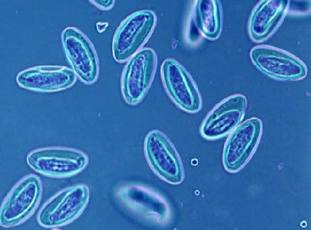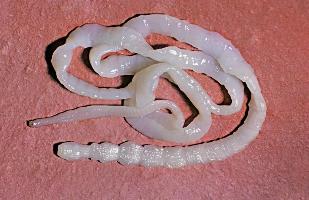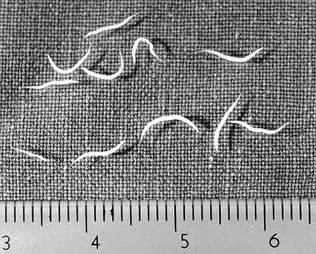
Helminthiasis, some of the most common diseases among both children and adults. The human body can be a parasite to various types of intestinal worms. It is generally agreed, is far removed from medicine, and that helminths be surprised only in the digestive system, it is, in fact, worms can be parasitic in nearly all of the internal organs – the liver, the lungs, the heart, the brain, the mind, but also in the skeletal muscle, subcutaneous tissue and into the eye. The article reports on the worm there is to the man.
Rating
There are a huge number of worms that can afflict a person, the following are the most common of them. The majority of the non-commercial belongs to one of 3 groups, trematodes, cestodes, or of the ancilostomídeos.
Trematodes, is in a class of worms that infest the way, lisa, aware of the about 40 types of worms that affect humans. The most common of these are:
- cat or siberian fluke (it's called opisthorchiasis);
- schistosoma (causes the disease).
Cestodes, is a strip in the plane of the time. The representatives of cestóides to a lack of the digestive system. More often than not the man is striking:
- the high-cosmopolitan (it's called beef tapeworm infection);
- the pig tapeworm (is called cysticercosis);
- Echinococcus (it's called " Echinococcusoz).
Hookworm infection is a worm parasites, you initially sit up. The common helminthes, with a male:
- pinworms;
- the guinea-worm;
- the genus meloidogyne.
Worms in humans — the symptoms are the photos of most of the worms that affect the digestive system, starting from here, such as nausea and vomiting, diarrhea or constipation, obstruction of the bowel, free weight loss, such as loss of appetite or excessive hunger):
Cat or siberian fluke

Cat or siberian fluke – a very small parasite-lanceolate form, from a bunch of worms in the liver. The causative agent of the disease in opisthorchiasis. The length of the cat-sole, reaches the 8-to 18-millimeters, a width of 1.2-2 mm long. The parasite develops in the bodies of the two men in the middleware and the destination. The intermediate host – fresh seafood and fish, the carp, the fate of a human being.
Together with the stool (feces) of infected people and animals, the eggs fall to the unleavened bread the bodies of water, where they gobble up clams. In the body of the snail eggs to achieve the non-invasive stage, cercaria, cercaria leaves the snail and is embedded in the body of a fish, a carp, or a fall in their bodies from eating fish, and shellfish. In the body of a fish the parasite develops in the meta-cercaria, which is located in the cyst of ovarian, dimensions, reaching to a 0.17-0.21 mm.
When you eat seafood infected with the infected with the person in their body of the meta-cercaria leave the cyst from the stomach and intestine go to the liver and the bile ducts. In these bodies, they are a parasite, and by 10-12 days to reach the Mature stage, they begin to lay eggs. In the body of a man, cat fluke can be a parasite for 10 to 20 years.
Schistosoma
Schistosoma – blood flukes. It's simple, dioecious helminths, and of a length that reaches to 4 to 20 mm, a width of 0.25 mm. The body of the schistosoma is equipped with 2 suction cups) – oral, the abdominal, and they are all located in close proximity to each other. The females of schistosoma longer and more slender than in the male. In the body of a male has a longitudinal hole, and with your help, he remains with the woman. The eggs are 0.1 mm in diameter, of an oval form, on a surface of one of the poles, there is a big question).
The human flukes schistosoma in the role of the definitive host people in their bodies, they are parasites of the small veins in the colon, the abdomen, the uterus, the urinary bladder. The worms feed on blood, which is partially absorbing the nutrients through the cuticle. The eggs of schistosoma are transported to the intestine and the urinary bladder, where they mature and stand out to the outside along with the stool (feces) or urine. In fresh water the egg comes out a larva (plural larvae), the middle-of-hospitality – trading. In the body of the snail meta-cercaria develop to cercaria, 4-8 weeks.
The high-cosmopolitan

The high-tapeworm – tape, the parasite causing the disease, beef tapeworm infection. This is the helminths, that are capable of growing 3 to 12 feet in length. In the body of the parasite is the small, head with a diameter of about 3 mm, and the neck, and around 1000 lines. Once you get in the human body, together with the non-heat-treated-contaminated with the meat of them attaches to the walls of the small intestine via 4 suction cups.
In hermaphrodites, the proximal joints are laid the eggs of the helminths each year, an individual sets up to $ 600 million in eggs. Similar to helminthes and human diseases, parasitic in the intestine of a 20-years-old or more, and if there is no timely treatment.
The pork tapeworm
The pork tapeworm, such as high, it has 4 suction cups, but other than that, the body of the helminth ova has twice the batter in this manner. Up to two or three feet in length. You have pork tapeworm trilobal in the womb, on each side of the uterus has 7 to 12 branches. A distinctive feature of the helminths – the ability of the segments to crawl out of the anal opening. After you have come out of his sheath and becomes dry and on top of this, both in the external environment fall, the eggs of the helminth ova. The host intermediary, the tapeworm, can be a pig and a man.
The primary host is the human. Intestinal worms in humans, which include the tapeworm, helminths are located in the patient's intestine, where it lays its eggs. The infection occurs when the use of non-invasive to the flesh.
Echinococcus
Exciter Echinococcusozа in length, it reaches 3-5mm. It consists of the head, where you will find the four pads, and the corolla-hooks, and three or four pieces. The last one of the segments that have developed to the sexual by the system. The intermediate host for the breeding of cattle or for the people, the boss – dog, the wolf. The infection occurs in the oral route.
Echinococcus enters the small intestine from the eggs, leaving the larvae. With the help of the hooks, the larvae penetrate into the system to the portal vein, where it, along with the blood, that are released into the liver, lungs, and muscle tissue.
Pinworms

Pinworms – roundworms, are the cause of enterobiasis, called the disease of dirty hands. The greater the degree of contamination in worms, may affect your child. The infection occurs in the oral and contact plyfit the only way. It is possible to detect these worms in the stool.
The adult females of the helminthes, a type of pinworms in length to achieve a 5-to 10-mm, male – 3 mm. The shape of the body, which the worms spindle-shaped milky white in color. The purpose of the body of the female is slightly reduced. The adult worms are parasites in the lower departments of the fine and the large intestine of a human, to attach to the wall with the help of the aches and pains of the head with a bladder. To lay their eggs, the females are the worms in your rectum, crawl out to the outside and lay their eggs in the anal area, after you die. Outstanding, and the eggs become invasive after 4 to 6 hours. The life-time of worms – a couple of months.
The dolls
The dolls – although some of the representatives of a class of parasitic worms, are the cause of billion with ascaris. It is helminths yellowish – pink color, they have the top of the axle-tree, in the form of a dioecious. The female Ascaris are growing up to 20-40 cm, with the males reaching a length of 15-25 cm. Each day, an adult female guinea-worm lives more than 200 thousand eggs, which, together with the stool (feces) of a person to stand on the outside, where in 12 to 14 days, if they become invasive.
In the body of a human parasitic diseases in the gastrointestinal tract, and is located mainly in the small intestine. A full cycle of the development of the non-invasive egg to Mature stage takes about 3 months.
The genus meloidogyne
The genus meloidogyne workshops and helminths, which cause the trihozefalez. Helminths represent a thin, brown, pinewood nematode, with fine, threadlike part of the front and rear of the rounded end. The female whipworm growing to 3.5-5.5 inches and males up to 3-4,5 cm long. The larvae of the worms in humans are located in the intestine, the blind, and where development to the stage of puberty, where they lay their eggs in it. When a massive infestation by helminths may also get the colon, including the rectum.
Each day, the female whipworm they will come to 3.5 billion eggs in it. The eggs of the helminth ova are barrel-shaped, covered with a thick, brown shell, on the poles located in clear "accent". The eggs fall to the ground, along with the preparation to host the parent if there are favourable conditions, they may be able to save the raiders from the property for up to two years. Duration of free-riding in the intestine of man, in between 5 and 7 years old.






































